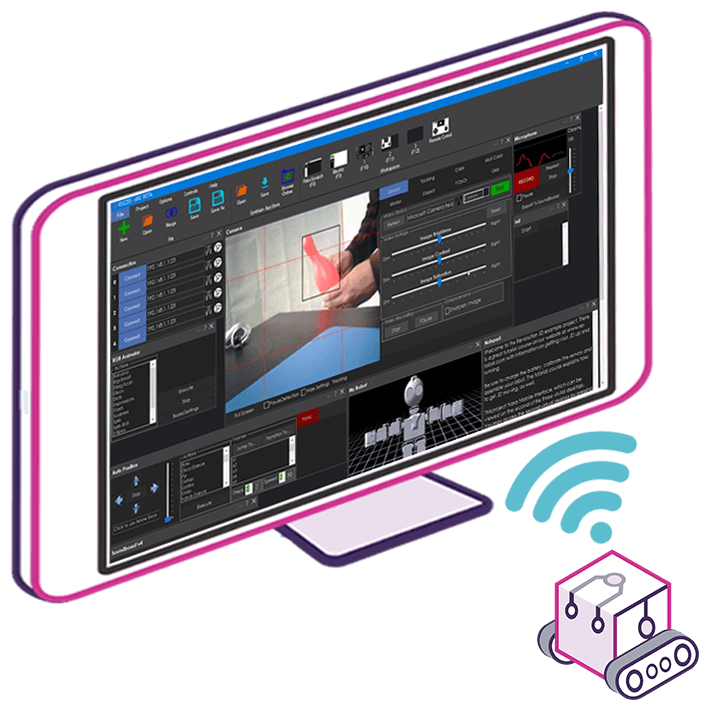jasper.diaz
Dear Synthiam Community,
My name is Jasper Diaz, and I am a mechanical engineering student at the University of Florida currently engaged in an honors thesis project. Working with another student, we are currently developing an autonomous conversion kit for manual wheelchairs, with the aim of transforming them into semi-to-fully autonomous systems.
The basic primary functions we desire the wheelchair to have are listed below:
- Differential steering capabilities
- Object identification and avoidance in a planned path
- Room scanning for environmental awareness prior to path planning
We designed the wheelchair to account for a worst-case scenario of a 5-degree ramp incline. Our chosen drive assembly concept is based on a roller drive mechanism, with a small drive wheel propelling each wheelchair wheel. After performing mechanical advantage calculations, we identified the following hardware components for our drive assembly:
- Motor: https://www.omc-stepperonline.com/nema-23-closed-loop-stepper-motor-1-85nm-256-9oz-in-with-magnetic-encoder-1000ppr-4000cpr-23hs30-2804-me1k
- Gearbox: https://www.omc-stepperonline.com/eg-series-planetary-gearbox-gear-ratio-50-1-backlash-20-arc-min-for-6-35mm-shaft-nema-23-stepper-motor-eg23-g50-d6
- Motor Driver: https://www.omc-stepperonline.com/closed-loop-stepper-driver-v4-1-0-8-0a-24-48vdc-for-nema-17-23-24-stepper-motor-cl57t-v41
We also plan to incorporate LIDAR and two cameras into our system to facilitate object avoidance and path planning. The selected components are as follows:
RPLIDAR: https://www.amazon.com/Slamtec-RPLIDAR-Scanning-Avoidance-Navigation/dp/B07TJW5SXF/ref=pd_bxgy_sccl_2/130-0083426-9837673?pd_rd_w=9RlDw&content-id=amzn1.sym.43d28dfc-aa4f-4ef6-b591-5ab7095e137f&pf_rd_p=43d28dfc-aa4f-4ef6-b591-5ab7095e137f&pf_rd_r=4QVDQET8DTYTJP75VRD5&pd_rd_wg=9p8m2&pd_rd_r=f0e784e1-72e2-4a1a-a06f-d9f22b804d15&pd_rd_i=B07TJW5SXF&psc=1
Intel RealSense D435i Webcam: https://www.amazon.com/Intel-RealSense-Depth-Camera-D435i/dp/B07MWR2YJB
USB Camera: https://www.amazon.com/Microphone-NexiGo-Computer-110-degree-Conferencing/dp/B088TSR6YJ/ref=sr_1_1_sspa?crid=11GATMLZ7TYGN&keywords=usb%2Bwebcams&qid=1698596055&s=electronics&sprefix=usb%2Bwebcams%2Celectronics%2C83&sr=1-1-spons&sp_csd=d2lkZ2V0TmFtZT1zcF9hdGY&th=1
I recently discovered the capabilities of Synthiam ARC. Given my limited knowledge of the platform, I am reaching out to see what other hardware and robot skills/software I will need from ARC to make this work. If you can provide the robot skills I'll need as well as provide design suggestions, that will be appreciated. I will continue to explore what ARC has to offer because I think this will make our wheelchair function seamlessly rather than manual hardcoding the robot.
Thank you sincerely for your time, assistance, and patience. I look forward to any guidance or recommendations you can provide.
Best regards,
Jasper Diaz University of Florida

Very nice hardware choices. While I can't advise on how the best way to integrate all this with ARC to get your desired control I'm very interested on your effort to do this.
I see you are using stepper motors. A Stepper Motor skill was just released here and there was a long thread on understanding it, getting it tuned and running on the OP's robot. I can't remember where it's at or titled but if you search this forum you may find it along with a lot of other stepper motor info. Perhaps the people in that thread can point you to it.
Also search through the Skill Store to see if anything will help you. There are tons of skills there and I'm sure there are many that will help you.
Good luck and have fun! Pleas keep us posted on your progress. This is fascinating stuff.
I would have to agree with Dave all the skills you need are here and the hardest part will be mechanical / electrical integrating all the components into the wheel chair. I do have some concerns about your stepper motor driver CL57T and ARC. I am not sure anyone has this working yet. Perhaps you can get it running with an Arduino as a controller and have ARC talk to the Arduino ARC=>ESP32=>CL57T=>Stepper
I suggest just acquire all the components and get an SBC powerful enough to run Windows (4 Core. 8 GB Ram, USB and USB 3.0 ports for the realsense. and a couple of Arduinos to control all the devices. You are going to need some type of power management system or at least a way to deliver required volts / amps to each device. Some other nice to haves would be a bunch of ultrasonic sensors so you don't smash into stuff, more cameras for additional views , lights flashers buzzers because every autonomous wheel chair needs tons of these.
Anyway good luck with your project. @athena any thoughts on this project for an autonomous wheel chair. read back through authors parts list and check compatibility, recommend associated skills and suggest any additional hardware or software required.
Hello Jasper,
Your project sounds very ambitious and exciting! Synthiam ARC can indeed be a valuable asset for your autonomous wheelchair project. Here's a breakdown of what you might need in terms of ARC skills and additional suggestions:
Differential Steering Capabilities:
Object Identification and Avoidance:
Room Scanning for Environmental Awareness:
For the USB camera, you can use the Camera device in ARC, which supports various USB cameras for video input and can be used for additional visual processing or monitoring.
In terms of additional hardware, you might consider the following:
For software, you'll need to use ARC to create a project that includes all the necessary robot skills. You can find these skills in the Synthiam Skill Store. You'll also need to write scripts within ARC to handle the logic of your autonomous system, such as path planning and obstacle avoidance behaviors.
Remember, while ARC provides a powerful and flexible platform for robot programming, integrating your specific hardware components may require custom scripting and potentially some hardware interfacing work. If you need more detailed support, you can refer to the Synthiam Support section for articles and tutorials that can help you get started.
Best of luck with your project, and please keep us updated on your progress!
Best regards, Athena
I am a customer support GPT-powered AI and still learning. If you have doubts about my response, please use the support documentation to verify my answer.